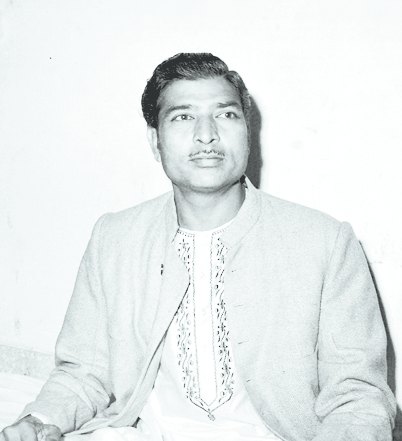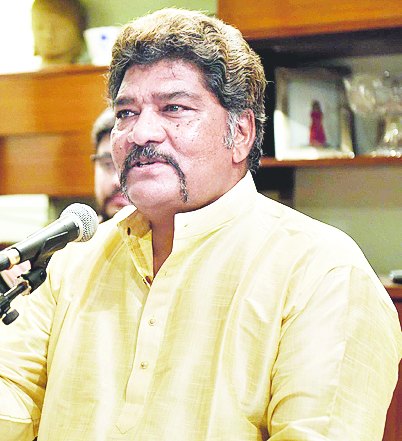MUSIC – Payel Sengupta
Pride, aristocracy and tradition: these components of Indian classical music are synonymous with a gharana known as the Agra Gharana. This gharana reached its zenith during the reign, as it were, of the illustrious maestro, Ustad Faiyaz Khan. He had an unparalleled, unique style of singing. The flow of the Agra Gharana had developed a new stream with the blending of another prestigious gharana, Atrauli (especially a gharana of Jaipur).

Ustad Sharafat Hussain Khan, a practitioner of the Atrauli Gharana, was adopted by Ustad Faiyaz Khan at the tender age of eight, and was introduced to the Agra Gharana. The young Sharafat surprised the musical doyen with his voice. But he was only twenty when his mentor died. In the meantime, Sharafat started gaining a reputation as the promising vocalist. After the death of his beloved mentor, Sharafat took his training from Ustad Ata Hussain Khan of the Atrauli Gharan and Vilayat Hussain Khan of the Agra lineage.
That was the post-Independence era of Indian classical music; the arena of classical music was being dominated by names like Bade Ghulam Ali Khan, Roshan Ara Begum, Ustad Nissar Hussain Khan, Ghulam Mustafa Khan and D.V. Paluskar. But Sharafat became the busiest artist at that time for his distinctive potential. The priceless compositions ( bandishes) of the Agra Gharana found a new life in the voice of Sharafat Hussain Khan. His sudden demise was undoubtedly a blow to the glory of the Agra and the Atrauli gharanas. Probably to revive these incomplete, lost memories of Sharafat’s singing, his disciple, Vidushi Purnima Sen, organized a programme in commemoration of her guru’s death anniversary, where the principal attraction was the vocal recital by Sharafat’s son, Shaukat Hussain Khan. But before Shaukat’s performance, the programme commenced with a sitar recital by Agnibha Banerjee. He enchanted the listeners with his simple and sweet alaap, jor and jhala in Poorvi and gats in Shyam Kalyan.
Shaukat commenced his performance with the Raga Shudhha Kalyan. The Agra Gharana has a distinguished feature in which the alaap is sung in an elaborate, vast manner, with the variation of vistaars like Dhrupad and Dhamar. Maintaining this tradition, the artist presented a long alaap and overwhelmed the audience. His touches on a specific note from one octave to another without interruption were especially attractive. His smooth, generous rendition completed a circle of varied moods. The drut kheyal also became interesting for the ornamented taans and vistaars in the antara.

Shaukat’s next presentation was the Raga Yogkaus. Like the previous performance, the artist again presented an elongatedalaap which brought out the soul and beauty of this particular raga. He made an exceptional utilization of pancham which increased the charm. Shaukat is blessed with a wonderful, generous voice, and has an expert dominance over every octave, which is a very special attribute of his gharana. The munificent gift of his voice brought his ancestor’s memory alive. The kheyals on Yogkaus were a typical, attractive presentation of the Agra Gharana.
Suhaag Sugrai is a very special raga of the Agra Gharana. Shaukat performed this raga with the greatest supremacy. The most enjoyable part was the briefkheyal which was embellished with small vistaars and smart, forceful taans. After a beautiful aochaar, he sang a famous bandish of his gharana, “Gha Gha Ghana Ghana” in the Raga Surmalhaar, which reminded the audience of his father. He made a proper tuning to this composition, which was followed by the Raga Megh. Shaukat’s mighty voice helped in the full bloom of the raga, and the compositions like ” Garaje Ghata Ghana Ghor” and especially the drut bandish, ” Dhume Dhame Aawe“, were able to create an atmosphere of thunderstorms on that sultry summer evening. A robust masculinity is a hidden beauty of the gayaki of the Agra Gharana, and Shaukat Hussain Khan perfectly fits this category. He skilfully shifted to a soulful ambience from the storm and started singing a prominent tappa, “Miyan Bejanewale” based on the Raga Kafi, which portrayed not only the musical prowess of the artist, but also drew up the light of nostalgia. He sang a brief kafi tarana in a cheerful manner. Shaukat concluded with a popular dadra of his ‘Ghar’, ” Banao Batiyan“, which reflected an essence of the golden period of Indian classical music. He touched every note carefully with a mellifluous style. Shaukat was perfectly accompanied by Sujit Saha on the tabla.
Shaukat shared some personal feelings with the audience which included some memories of his father. According to him, Sharafat Hussain Khan used to practise only Bhairav and Yaman, but always sang the tough and rare ragas like Patmanjari, Jhinjhoti and Dhaneshree while performing on stage. He never refused the requests of his listeners. It seemed that his son probably got the same training in the ragas, because he seemed to fulfil the wish lists of his listeners. Perhaps there could have been no better way to commemorate his father’s death anniversary.
source: http://www.telegraphindia.com / The Telegraph, Calcutta, India / Front Page> Opinion> Story / by Payel Sengupta / Saturday – May 23rd, 2015









I am a common music listener from Kerala,nearing my 70s.Can I get the contact details of Shri Shoukat Hussainkhan?